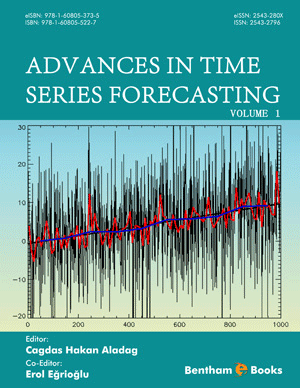Introduction
Page: 1-13 (13)
Author: Bicheng Yang
DOI: 10.2174/978160805242411101010001
PDF Price: $15
Abstract
In this chapter, we introduce some evolvements for th e theory and methods of Hilbert-type inequalities, including Hilbert’s inequality. We must emphasize some excellent works on discrete Hilbert-type inequalities and Hilbert-type operators with multi-parameters in recent years, which have made more developments in this context. This chapter will enhance the understanding of the readers of the content of the following several chapters.
Improvements of Euler -Maclaurin’s Summation Formula: Preliminary Theorems
Page: 14-26 (13)
Author: Bicheng Yang
DOI: 10.2174/978160805242411101010014
PDF Price: $15
Abstract
In this chapter, for optimizing the methods of est imating the series and weight coefficients, we introduce some preliminary theorems of improving Euler-Maclaurin’ s summation formula. A few useful corollaries and inequalities are considered. By the way of applications, some new inequalities on Hurwitz ζ-function restricted in the real axis are given.
Hilbert-Type Inequalities with the Homogeneous Kernel of Degree -1
Page: 27-53 (27)
Author: Bicheng Yang
DOI: 10.2174/978160805242411101010027
PDF Price: $15
Abstract
In this chapter, by using the way of weight coefficients and the technique of real analysis, some basic theorems and corollaries on the discrete Hilbert-type inequalities with the homogeneous kernel of degree -1 are given. We apply some relating results mentioned in Chap ter 2 to building some Hilbert-type in equalities with a particular homogeneous kernel of degree -1. The strengthened vers ions, the reverses and the more accurate Hilbert-type inequalities are considered. The proofs about the best possible property of the constant factors are left in Chapter 4. In some particular examples of this chapter, the improved Euler-Maclaurin summation formulas mentioned in Charter 2 and are used here.
Hilbert-Type Inequalities with the General Homogeneous Kernel
Page: 54-89 (36)
Author: Bicheng Yang
DOI: 10.2174/978160805242411101010054
PDF Price: $15
Abstract
In this chapter, Hilbert-type inequalities and the re verses with the general homoge neous kernel of the real number degree and the best constant factors are considered, which are some ex tensions of the results in Chapter 3. By using the improved Euler-Maclaurin summation formula and the technique of real analysis, some particular examples with the best constant factors are given.
Some Innovative Hilbert-Type Inequalities
Page: 90-121 (32)
Author: Bicheng Yang
DOI: 10.2174/978160805242411101010090
PDF Price: $15
Abstract
In this chapter, based on some theorems of Chapter 4, by using the technique of r eal analysis and applying the improved Euler-Macraurin’s summation formula mentioned in Chapter 2, we discuss how to use some particular parameters to denote some new Hilbert-type inequalities and the reverses with the best constant factors. A class of Hilbert-type inequalities with the general measurable kernels is considered.
Multiple Hilbert-Type Inequalities
Page: 122-152 (31)
Author: Bicheng Yang
DOI: 10.2174/978160805242411101010122
PDF Price: $15
Abstract
In this chapter, by using the technique of real analysis and the way of weight coefficients, we establish some lemmas and obtain two equivalent multiple Hilbert-type in equalities and the reverses with the general homogeneous kernel of real number-degree and some variables, which ar e the best extensions of the corresponding results in Chapter 4. Some particular examples with the best constant factors are considered.
Abstract
Full Text Avaliable
Introduction
Discrete Hilbert-type inequalities including Hilbert's inequality are important in mathematical analysis and its applications. In 1998, the author presented an extension of Hilbert's integral inequality with an independent parameter. In 2004, some new extensions of Hilbert's inequality were presented by introducing two pairs of conjugate exponents and additional independent parameters. Since then, a number of new discrete Hilbert-type inequalities have arisen. In this book, the author explains how to use the way of weight coefficients and introduce specific parameters to build new discrete Hilbert-type inequalities and consider some applications. The book is intended to augment the reader's understanding of Hilbert-type inequalities.












